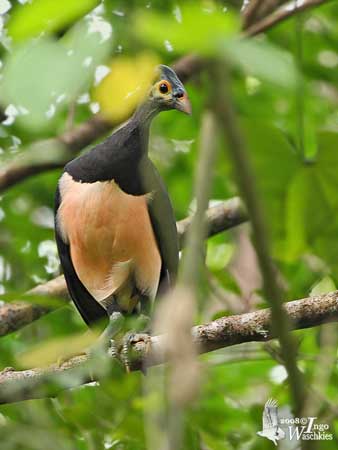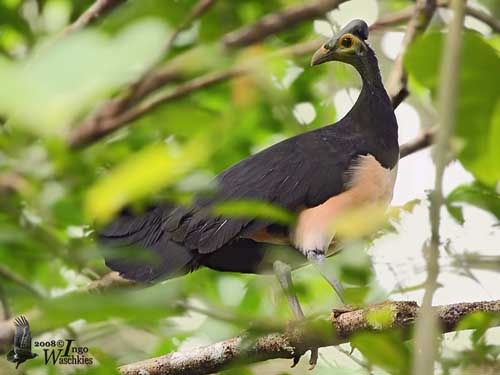
Fr: Megapode maleo
All : Hammerhuhn
Esp : Talégalo Maleo
Ital : Maleo
Nd: Hamerhoen
Sd: Maleohöna
Photographer:
Ingo Waschkies
Bird Photography
Text by Nicole Bouglouan
Sources:
HANDBOOK OF THE BIRDS OF THE WORLD Vol 2 by Josep del Hoyo-Andrew Elliot-Jordi Sargatal - Lynx Edicions - ISBN: 8487334156
BirdLife International (BirdLife International)
Wikipedia, the free encyclopaedia
Maleo
Macrocephalon maleo
Galliforme Order – Megapodiidae Family
BIOMETRICS:
Length: 55 cm
Weight: M: 1300-1600 g – F: 1500-1800 g
DESCRIPTION:
The Maleo is the sole member of the genus Macrocephalon, a monotypic species endemic to Sulawesi.
Both adults show an unusual adornment on the head, a black bony knob projected backwards. This knob reaches forwards down forehead towards the base of the upper mandible. It is mainly hollow and its function is unknown. However, it might be used as shock absorber when the maleo pecks strongly at hard nuts.
The bare skin of the face is yellow, and we can see a conspicuous orange-yellow eyering.
The upperparts, including wings and tail, but also head, neck and upper breast, are deep black.
Rest of underparts are white with pale salmon-pink wash of variable intensity, but the thighs are black, often hidden under the pale belly feathers.
The strong bill is pale reddish-orange and horn with brighter upper base. The eyes are dark brown. Legs and feet are greyish-blue. We can see a small membranous web between the toes. Claws are long and sharp.

The juvenile has dark brown upperparts, wings, tail, breast and head, and yellow underparts. On the head, the face is feathered yellow, and both knob and bright eyering are absent. The horny knob appears at about six months of age.
VOICE: SOUNDS BY XENO-CANTO
The Maleo uses different vocalizations according to the situation. When they gather near the nesting areas, they utter series of disyllabic rolls, probably acting as a kind of contact call.
When they start digging the nest-burrows, quarrels often occur and are continuously accompanied by calls, among them a loud braying and a duck-like quacking.
HABITAT:
The Maleo is usually found in lowland and hill forests, but sometimes up to 1200 metres. It breeds on beaches along the coast, or in clearings with sandy soil, and lakeshores.
RANGE:
The Maleo is found in Sulawesi and Buton (Butung) Island, off SE Sulawesi.
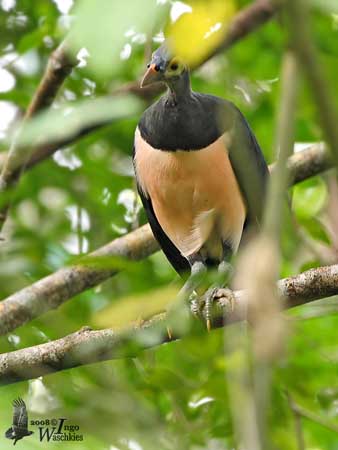
BEHAVIOUR:
The maleo feeds usually on fallen fruits, but also takes insects and other invertebrates found on the forest floor.
This is a very shy bird, mainly active at night, and at dawn and dusk. They are often in pairs and are gregarious birds. They are communal burrow-nesters, and often gather in large numbers in suitable laying grounds.
They usually arrive in late afternoon and wait in the nearby trees while calling continuously. Later, they emerge into the open where they are conspicuous.
They are monogamous with long-term pair-bonds. The pair defends its burrow from other pairs breeding in the same communal laying area.
The Maleo is probably mainly sedentary with short movements of some kilometres.
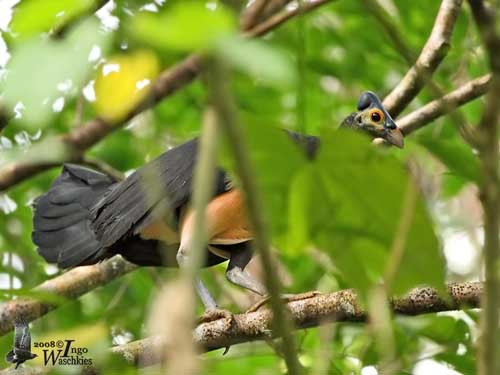
FLIGHT:
The Maleo has large, rounded wings. Its flying abilities are used for flying short distance when disturbed. It can perform a fast take-off to escape predators, but usually it flies a fairly short distance up into the trees.
REPRODUCTION:
The Maleo may breed all year round, with peak between October-April in N Sulawesi. Eggs are laid in May-July and November-January in SE Sulawesi.
They are monogamous with pair-bonds maintained all year round.
They lay the eggs at communal laying grounds, usually on solar-heated beaches and sandy soils, where the ground is heated by geothermal activity.
The burrow is mainly dug by the male and can reach up to 3 metres in wide and one metre in depth. The male digs with its strong feet, and finally, both sexes join forces to prepare this strange nest.
Once the burrow is dug and ready, the female enters and disappears into the burrow where she lays her eggs, usually 8-12 creamy-white eggs, typically between 20 and 60 centimetres below the surface. Then, the pair fills the burrow with sand and goes away from the site.
The incubation lasts 60-80 days, and hatching occurs without any parental help.
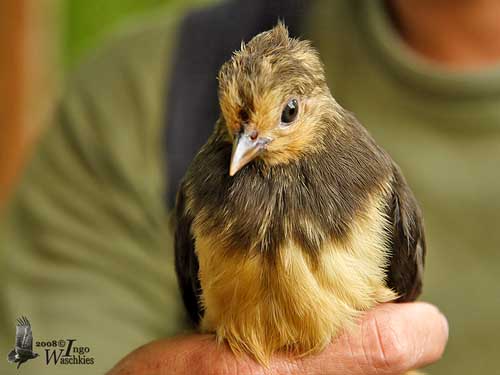
The chicks need almost a journey, sometimes two, to emerge from the sandy burrow, and they are very precocial. They are feathered and increase rapidly after the ten first days after hatching.
They are able to fly in the first day, to feed themselves and to regulate their own temperature.
They are fully grown at about 18-22 months old, and are probably sexually mature at two years of age.
They are vulnerable to predation of burrows and eggs by humans and monitor lizards.
DIET:
The Maleo feeds on fallen fruits and also takes insects and other invertebrates from the ground.
PROTECTION / THREATS / STATUS:
The Maleo is an Endangered species with small decreasing populations.
Harvesting of eggs and human disturbances related to the collect of eggs, are the main threat causing abandonment of the nesting colonies. Other threats such as deforestation and fragmentation of forest affect the surviving populations. Hunting of adult birds, agriculture expansion, human developments and spread of invasive vegetation also threaten this species.
Several conservation measures are active to protect the species with extension of protected areas and maintenance of the nesting grounds, artificial hatcheries are developed, and involvement of local people through public educational campaigns.
